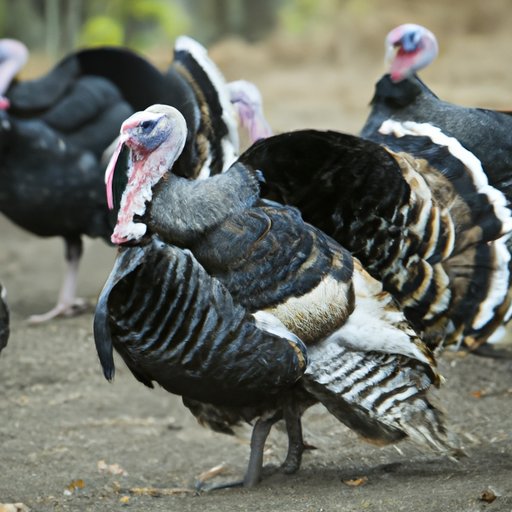Introduction
Turkeys are a popular source of food around the world, but how many turkeys are actually in the world? This article will explore the global turkey population in detail, looking at both wild and domestic turkeys, and assessing the impact of human activity, conservation efforts, and health concerns.

Statistical Overview of the Global Turkey Population
Estimating the total number of wild turkeys is not an easy task, as many wild turkey populations are difficult to access or monitor. According to the National Wild Turkey Federation, there are an estimated 7 million wild turkeys in North America alone. However, it is likely that the total number of wild turkeys around the world is much higher than this figure suggests.
The impact of human activity on wild turkey populations varies from region to region. In some areas, hunting and habitat destruction have led to a decrease in wild turkey numbers, while in other regions, the introduction of new agricultural practices and conservation measures have allowed for a steady increase in wild turkey populations.

Exploring the Role of Conservation Efforts in Protecting Wild Turkeys
Conservation efforts play an important role in protecting wild turkey populations from further decline. Existing conservation measures include habitat protection, hunting restrictions, and reintroduction programs. While these measures have had some success in increasing wild turkey numbers, more needs to be done to ensure the long-term survival of wild turkeys.
Potential new conservation strategies include increased public education and awareness about the importance of wild turkeys and their habitats, as well as better enforcement of existing regulations. Additionally, more research is needed to understand the impacts of human activity on wild turkey populations, as well as potential new methods of managing and protecting these birds.
Analyzing the Growth Rate of Domestic Turkey Populations
Domestic turkey populations have seen a steady increase in recent years, due to advances in breeding and production techniques. Factors such as improved diets, housing conditions, and genetic engineering have all contributed to the growth of the domestic turkey population.
Trends in domestic turkey breeding and production vary from country to country. In the United States, for example, there has been an increase in the number of large-scale poultry farms, which produce large quantities of turkeys for commercial sale. In contrast, in countries such as India, where backyard farming is more common, smaller-scale production is still the norm.

Investigating the Health and Wellbeing of Wild and Domestic Turkeys
The health and wellbeing of wild and domestic turkeys is an important consideration when discussing the global turkey population. Human interaction with turkeys can have a significant impact on their health, as humans can introduce new diseases and parasites into turkey populations. Additionally, poor animal husbandry practices, such as overcrowding and inadequate nutrition, can lead to serious health problems in turkeys.
Common health concerns affecting wild and domestic turkeys include avian influenza, salmonellosis, and parasitic infections. Vaccination and good biosecurity measures are key to preventing the spread of these diseases, and regular monitoring and testing is essential for identifying and responding to any outbreaks.
Conclusion
This article has explored the global turkey population, including estimates of wild turkeys, the impact of human activity on their numbers, conservation efforts, the growth rate of domestic turkeys, and common health concerns. It is clear that more needs to be done to protect wild turkey populations, including better enforcement of existing regulations, increased public education, and more research into potential new conservation strategies. Additionally, good biosecurity measures and regular monitoring and testing should be employed to prevent the spread of diseases among wild and domestic turkeys.
Overall, it is clear that the global turkey population is a complex issue, and one that requires further investigation and action.


